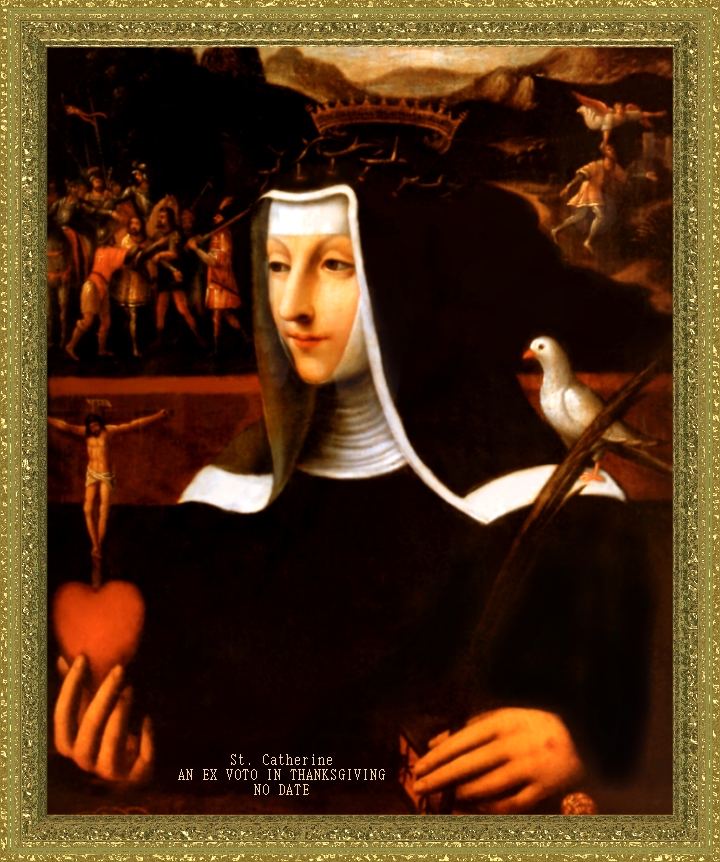

OF THE PASSION:
+++++++ Saint Catherine of Siena +++++++

| St.
Catherine of Siena: Biography Adapted by Catholic Tradition from SAINT CATHERINE OF SIENA by Mother Frances A. Forbes, a nun of the Society of the Scared Heart in Scotland who was a convert and highly regarded by Cardinal Merry de Val, a close friend of Pope St. Pius X. Nihil Obstat and Imprimatur, 1913. Currently published by TAN BOOKS. Chapter 7 THE PEACEMAKER  HE
two most powerful families in Siena were the Tolomei and the Salimbeni,
who were continually at war with each other. Catherine, having many
friends among them both, had done her best to make peace between them;
but the governors of Siena, who hoped that the two families while
quarreling with each other would have no leisure to fight with them,
did all that they could to keep up the feud. HE
two most powerful families in Siena were the Tolomei and the Salimbeni,
who were continually at war with each other. Catherine, having many
friends among them both, had done her best to make peace between them;
but the governors of Siena, who hoped that the two families while
quarreling with each other would have no leisure to fight with them,
did all that they could to keep up the feud.A fresh dispute now threatened to divide the Salimbeni. The head of the family died, and his young son Agnolino, wishing to be on peaceful terms with the republic, caused himself to be enrolled among the plebeian families of Siena and declared himself ready to support the cause of the people. Cione Salimbeni, Agnolino's quarrelsome and ambitious kinsman, jealous at the popularity which the young man had won by this proceeding, hastened to pick a quarrel with him, and civil war seemed likely to end the dispute. Countess Bianchina, the mother of Agnolino, and Stricca, the wife of Cione, were both devoted friends of Catherine, and it was to her that they turned in their distress. Their great castles lay ten miles apart among rocks and mountains, in a wild and savage country peopled only by chieftains who spent their lives in fighting and whose soldiers were little better than bands of robbers. Catherine went first to Castiglioncella, the stronghold of Cione, who received her cordially and, although he had refused to listen to anyone else, consented at her request to give up the quarrel. Agnolino was reported to be equally obstinate, but Catherine's first success had made her hopeful. She set out at once for the great castle of Rocca d'Orcia, where he was living. To the men who dwelt in that wild region, prayer and the Sacraments had been unknown for years. Their cruel and violent lives had hardened their hearts, but the very appearance of Catherine seemed to bring with it an atmosphere of charity. It was not long before her influence brought about the longed-for reconciliation. The neighboring lords and chieftains came under the spell and at Catherine's prayer were ready to lay aside their quarrels and to make peace with their enemies. Every day brought some fresh work to do for God, and so it came to pass that Catherine's visit at Rocca d'Orcia lengthened from days into months. Countess Bianchina would gladly have kept both Catherine and her companions forever, such was the love and admiration in which she held her, and the country people, hearing of the presence of the Beata Popolana in their midst, came flocking to the castle. Not only did they bring with them their sick, but even people possessed by devils, for they had heard of the wonderful cures effected by Catherine's prayers, or even the touch of her hand. Francesco Malevolti, one of the young noblemen who was with Catherine at Rocca d'Orcia, has left us an account of the scenes which took place in his presence. One day twelve peasants appeared carrying an unfortunate man bound with ropes and with heavy shackles on his hands and feet. He was a demoniac, they said, who had already injured several persons in a fearful manner, biting and tearing with his teeth all who approached him. They had consented to carry him to Rocca d'Orcia on condition that he was very securely bound, but they had had an extremely difficult task to get him there. Indeed, the man, whom they had laid down in the courtyard, was screaming and roaring in a manner that seemed hardly human, glaring and trying to bite those who came near him, like a wild beast. Word was brought to the Countess Bianchina, who asked Catherine if she would come with her to the courtyard, without telling her the reason, for she was always very reluctant to meddle with such cases. At first she resisted, but overcome at last by the entreaties of the Countess, she went to the courtyard, followed by most of the household. At the sight of her the demoniac uttered such terrible cries and struggled so furiously in his bonds that all were afraid; but Catherine, turning to the Countess, asked her: "What has this poor man done that he should be so cruelly bound? For the love of God bid them set him free; do you not see how he is suffering?" Then turning to the men: "Dearest brothers," she said, "do not leave this creature of God in such pain; loose him and give him some refreshment. There is nothing the matter with him." "Lady," they replied, "he has injured several of our people fearfully; still, if you will promise to remain near us we will set him free at your command." Then Catherine came close to the poor creature and bade them loose him in the name of Jesus Christ: at which words he lay quite still and let the men handle him without moving. "Now," said Catherine, "lift him up, he is very weak and needs refreshment. You will see that when he has had some food he will be no longer the same man." No sooner was the demoniac set on his feet than he came humbly and knelt down before Catherine, who blessed him with the Sign of the Cross. He remembered nothing of what had passed and was very much astonished to find himself at Rocca d'Orcia instead of in his own village, not knowing how he had gotten there. They gave him something to eat, after which he left the castle in perfect health with those who had brought him and was never troubled in the same way again. Don Francesco tells us of several other cases of the same kind which were brought to Catherine and which were cured in the presence of Countess Bianchina, Fra Santi, Fra Raimondo and several others, besides the members of the household. The fame of the Beata Popolana spread far and wide. The people came pouring into the castle to see and hear her. Men and women who had not been to the Sacraments for thirty or forty years and whose lives had been spent in the contempt of God's laws were seized at the very sight of her with sorrow for their sins. Fra Raimondo and the other friars were kept all day in the confessionals, so that they had scarcely time to take food; but Catherine's joy was so great that they forgot their weariness to exult with her over the harvest that was being gathered for God. The news of what was passing even reached Gregory XI in Rome, who granted special powers to Fra Raimondo and his colleagues and sent others to help them in their ministry. While all this was going on at Rocca d'Orcia, Lapa and the others who had been left behind at Siena were crying out at Catherine's long absence. "Dearest Mother," she wrote, in answer to a piteous complaint from Lapa, "your miserable child is in this world for one thing, and that is to do the will of her Creator. I do beg of you, if I remain here longer than you like, do not be vexed ... I am persuaded that if you knew the whole business you would be the first to tell me to remain." The governors of Siena then took it into their heads to imagine that Catherine and Fra Raimondo were plotting with the Salimbeni against the republic and wrote desiring her instant return. She had some difficulty in persuading them that they were mistaken. "We are only plotting to defeat the devil," she writes, "and to deprive him of the lordship that he has assumed over man by mortal sin, and to take hate from man's heart and pacify him with Christ Crucified and with his neighbor. These are the plots that we are weaving." But these contradictions were nothing to what was to follow. The Pope, having heard much of Fra Raimondo's wisdom and holiness, summoned him to Rome to make him Prior of the Minerva-----the head church of the Dominicans. Fra Raimondo had been Catherine's confessor for years, as well as her most devoted friend. No one understood her or helped her as he did, associated with her, as he had been, in all the most wonderful events of her life. But God asked, and she gave with a brave heart. They were to meet again but once in this world. "The suffering I have experienced," she wrote to Alessia, who shared all her secrets, "has reminded me of my want of virtue and made me know my own imperfection. Rejoice then on the Cross with me, for the Cross is the bed and the table of the soul whereon she rests and takes her food, even the fruit of patience, in peace and repose." Fra Raimondo's journey to Rome was to bear directly on Catherine's life. On his way he stayed for a short time in Florence, where he was assured by one of the rulers that the people as a whole desired peace with the Pope and that the war was only kept up by a small party in the State to suit their. own interests. He mentioned this to Gregory when he reached Rome, and a few days after, as they were talking together, the Pope said suddenly: "I believe that, if Catherine were to go to Florence, peace might be secured." The whole matter was arranged within a few days. The refusal of the Florentines to come to terms was a great distress to the Pope, whose health was failing fast. "May God give him grace to be courageous and never to turn back on account of any difficulty," wrote Catherine to Fra Raimondo; "may he be firm and constant, not fearing labor, hungering only for God and for souls and not troubling himself about temporal losses. Dear Father," she adds, "stand by His Holiness and be full of courage; do all you can for God and for souls until death." She set out for Florence shortly afterward with her mother, Stefano Maconi and several other companions. The interdict, the most terrible punishment that could afflict a rebellious people, had now lasted for seventeen months. The city groaned under the burden, and the government, fearing that the growing discontent of the Florentines would force them to submit to the Holy See, had issued a decree ordering priests to disregard the Pope's authority and to administer the Sacraments as before. All who were loyal churchmen left Florence; those who preferred to submit to the rulers of the Republic remained and obeyed their decree. The first thing to be done was to put a stop to this open violation of the Pope's commands. Catherine assembled the members of the government and addressed them three times with such convincing eloquence that they agreed to observe the interdict. Stefano Maconi has described for us the scene where one frail woman, quietly facing the leaders of a revolution, by sheer force of holiness bent them to her will. The question of peace had now to be considered. We have already seen that there were two parties in the State: one for peace and one for war. The latter, who thought only of their own private interests, were not likely to be moved by Catherine's arguments. Even the members of the peace party quarreled among themselves and would not take her advice. The people began to murmur, and the war party, taking advantage of the growing discontent, told them that Catherine was the cause of all the disturbance. The mob at last broke loose, burning and sacking the houses of several of the rulers, and breaking into the prison, set free the criminals, who joined their ranks. Goaded on by the members of the war party and reinforced by all the ruffians in the town, they set out in search of Catherine, who had taken refuge in a garden, shouting, "Let us take that wicked woman and burn her or cut her in pieces." The shouts and cries came nearer and nearer, and still Catherine prayed on peacefully, surrounded by her people. When the savage mob burst into the garden, she went quietly to meet them and knelt humbly at the feet of the foremost ruffian, who was brandishing a sword. "I am Catherine," she said; "do to me what you will, but do not touch my companions." At these words the man's courage seemed to fail him: "Flee," he cried, "flee!" "I am very well where I am," replied Catherine; "where would you have me go? If you mean to kill me, do so. I shall not resist." At this the man turned with all his companions and left the garden. The danger was over and all rejoiced. Catherine alone was sad, for she would have been glad to give her life for Christ's Church. The terror in the city was so great that no one dared to receive her, but she had declared that she would not leave Florence until peace was made. She retired with her companions to a solitary place outside the town but within the bounds of the city. The riots still continued. In the meantime Gregory XI died and Urban VI was elected Pope. Catherine at once wrote to him on behalf of "the sheep who are out of the sheepfold. Let Your Holiness triumph over their hardness of heart," she continues, "and have pity on the souls that perish. Do with me what you like, only grant me the favor I ask of you, miserable as I am." The rulers were growing anxious, for the city was in a ferment. In the beginning of July 1378 the terms of peace were finally settled. A messenger from Rome rode through the gates carrying a branch of olive in his hand according to the custom of the time. Catherine, writing in her joy to her disciples at Siena, sent a few leaves from the precious bough that meant so much to Florence. "O dearest children," she writes, "God has heard the cry ... of His servants ... And even as persons who now begin to see, they say: Thanks be to Thee, O Lord, Who hast reconciled us with our Holy Father ... Rejoice, exult in Christ sweet Jesus ... Now is made the peace, in spite of those who would have prevented it." |

 E-MAIL
E-MAIL
HOME--------------THE PASSION---------------SAINTS
www.catholictradition.org/Passion/siena7.htm